Assessing the Energy-Saving Potential of a Dish-Stirling Con-Centrator Integrated Into Energy Plants in the Tertiary Sector
Abstract
:1. Introduction
- the analysis proposes the integration of the detailed modelling of the dish-Stirling concentrator with the ones of the heat pump and chiller. Such an approach allows for a better understanding of the plant behavior, along with a more reliable assessment of the energy-saving and avoided CO2 emissions.
- the study investigates the feasibility of a cogeneration system based on the dish-Stirling technology, in localities characterized by Direct Normal Irradiation (DNI) lower than 2000 kWh/m2/y.
- in the second section, detailed modelling of all subsystems comprising the energy plant is presented;
- in the third section a description of the case study and the investigated energy systems configurations is provided;
- in the last section, the results are presented and discussed in detail.
2. Materials and Methods
2.1. Energy Model of the Dish-Stirling Solar Concentrator
2.2. Technical Features and Modelling of Reversible Air-to-Water Heat-Pump and Air-Cooled Chiller
3. Description of the Case Study
3.1. Description of the Reference Dish-Stirling Concentrator
3.2. Description of the Investigated Scenarios
- in System no. 1 (Figure 6a), an NG boiler is used to cover the thermal demand during the winter. In particular, hot water at 65 °C is supplied to fan coil units, and hot water at 45 °C to meet the DHW demand. Conversely, an air-cooled chiller covers the cooling demand during the summer. The electricity consumed by the lighting, office equipment, and the air-cooled chiller is purchased from the local grid;
- in System no. 2 (Figure 6b), a reversible air-to-water HP covers both heating and cooling demands. Regarding DHW, electric heaters are used.
- electric-mode: the dish-Stirling system produces only electricity, and heat is not recovered;
- cogenerative-mode: the dish-Stirling system produces both electricity and heat. To make such a heat flow useful for air-conditioning purposes, the temperature of the water exiting the cooler of the Stirling engine is increased from 40 °C to 50 °C. Such a temperature increase is achieved by shutting off the dry-cooler. A reduction in the efficiency and electric power of the solar concentrator is expected due to the higher compression temperature of the engine. However, the assumed increase of the Stirling-engine cold side temperature (about 10 °C) slightly affects the engine efficiency (about −0.05% is the observed reduction), according to the following experimental study [43].
- Scenario no. 1-A: as shown in Figure 7a, the dish-Stirling system produces only electricity which is used differently during the year. In particular, during the winter, such electricity is consumed by the lighting system and office equipment. Conversely, during the summer, it is also used to drive the air-cooled chiller. The thermal demand is covered using the NG boiler.
- Scenario no. 1-B: as shown in Figure 7b, the dish-Stirling system produces both electricity and heat, used differently throughout the year. In particular, during the winter, the recovered heat is supplied to the air conditioning system. As a consequence, a fraction of thermal demand is not met by the boiler, and the amount of NG consumed decreases. Moreover, the produced electricity flow is consumed by the lighting system and office equipment. During the summer, the produced electricity is used to supply the air-cooled chiller, the lighting system, and office equipment. However, the heat flow recovered from the Stirling engine is at 40 °C since only DHW is needed. Indeed, it is not convenient to recover heat at a higher temperature which would reduce the electric power.
- Scenario no. 2-A: as shown in Figure 8a, the dish-Stirling system produces only electricity which is used to operate the HP during the year. In those hours of low electricity demand, the electricity surplus is sold to the grid.
- Scenario no. 2-B: as shown in Figure 8b, the dish-Stirling system operates in a cogenerative mode. In particular, like Scenario 1-B, during the winter, the recovered heat flow is used to supply the air-conditioning system, while the electricity is consumed mainly by the HP. Conversely, during the summer, the produced electricity is used to drive the HP, the lighting systems, and office equipment. Moreover, in this scenario, like Scenario 1-B the heat flow recovered from the Stirling engine is only used for DHW purposes.
3.3. Notes on Performed Simulations and Definition of the Environmental and Economic Indicators
4. Results and Discussion
- for System no 1 (see Table 3) the NG consumed to cover the thermal demand was equal to 3970.4 Sm3/y. Conversely, electricity accounted for 63.64 MWhe/y. The amount of CO2 emitted for operating this plant was 38,107 kgCO2/y. Almost 81% of these emissions was due to the electricity purchase from the grid, while 19% was due to NG consumed by the boiler;
- for System no. 2 (see Table 4), since a reversible HP covers both cooling and heating demand, only electricity was consumed throughout the year. The annual amount was found to be 71.45 MWhe/y, which led in turn to the emissions of 34,653 kgCO2/y of CO2.
4.1. Results for Improved System No. 1: Scenario No. 1-A and 1-B
4.1.1. Results for Scenario 1-A
- a large share of the aggregated electricity demand (yellow profile in Figure 9a) is met by using the electricity produced from the dish-Stirling system (orange profile). The fraction of electricity demand which is not covered by the concentrator is purchased from the grid;
- focusing on a generic week in August in Figure 9b, the hourly dish-Stirling output power is simultaneous to the office demand, thus indicating that storage should not be installed. Conversely, on non-working days when electricity is not needed, the electricity is sold to the grid.
4.1.2. Results for Scenario 1-B
- as shown in Figure 10a, the electricity produced by the concentrator (green profile) can cover a large share of the entire aggregated electricity demand (yellow profile);
- as shown in Figure 10b, the profile of the electricity produced from the dish-Stirling system in electricity-mode and the one obtained for Scenario no. 1-B are compared. During the winter, the higher temperature of the cold-side of the Stirling engine, required by the cogenerative asset, leads to a reduction in the electric output power (see dashed black contoured rectangle). From the simulation, it was found that such a reduction is about 15% of the corresponding output power in electricity-mode.
- as shown in Figure 10c, the heat flow recovered covers at least half of the office thermal demand. Conversely, during the summer, a fraction of the recovered heat flow is used to cover the DHW demand.
4.2. Results for Improved System No. 2: Scenario No. 2-A and 2-B
4.3. Economic Results for the Four Analysed Scenarios
4.4. Brief Comparative Analysis of the Key Findings with Other Research
5. Conclusions
Author Contributions
Funding
Institutional Review Board Statement
Informed Consent Statement
Data Availability Statement
Conflicts of Interest
Nomenclature
| Symbols | Abbreviations |
| first parameter of the Stirling engine mechanical efficiency curve [-] | |
| second parameter of the Stirling engine mechanical efficiency curve [W] | |
| A | area [m2] |
| CF | cash flow [€/y] |
| DPBT | Discounted Payback Time [y] |
| E | electric energy [kWh] |
| electric power [W] | |
| h | convective heat transfer coefficient [W/(m2∙K)] |
| irradiance [W/m2] | |
| I0 | total installed cost of the dish-Stirling unit [€] |
| n | useful lifetime of the plant [y] |
| n | number |
| NPV | Net Present Value |
| Q | thermal energy [kWh] |
| thermal power [W] | |
| r | discount rate [%] |
| R | correction factor [] |
| T | temperature [°C] |
| FIT | feed-in tariff [€/kWhe] |
| mechanical output power [W] | |
| Greek letters | |
| Symbols | Abbreviations |
| emissivity [-] | |
| efficiency [] | |
| emission facto [kgCO2/kWh] | |
| the Stefan-Boltzmann constant [W/(m2∙K4)] | |
| Subscripts | |
| Symbols | Abbreviations |
| b | beam component of radiation |
| cle | cleanliness |
| e | electric |
| G | generation |
| in | inlet |
| n | net effective aperture area of the reflector CSP |
| p | parasitic component |
| o | optical |
| out | outlet |
| S | Stirling |
| sav | saving |
| r | receiver |
| t | t-th year of the lifetime of the plant [-] |
| T | Temperature |
| 0 | referred to the reference |
| Superscripts | |
| Symbols | Abbreviations |
| av | avoided |
| ave | average |
| Acronyms | |
| Symbols | Abbreviations |
| CO2 | Carbon Dioxide |
| COP | Coefficient of Performance |
| CSP | Concentrating Solar Power |
| DNI | Direct Normal Irradiation |
| GHG | Greenhouse Gases |
| HP | Heat Pump |
| HC | Heating Capacity |
| NG | Natural Gas |
| ODT | Outdoor Temperature |
| PCU | Power Conversion Unit |
| PLR | Part Load Ratio |
| TMY | Typical Meteorological Year |
References
- World Meteorological Organization (WMO). The Global Climate in 2015–2019. Report Published on 2019. Available online: https://library.wmo.int/doc_num.php?explnum_id=9936 (accessed on 7 January 2021).
- Berardi, U.; Jafarpur, P. Assessing the impact of climate change on building heating and cooling energy demand in Canada. Renew. Sustain. Energy Rev. 2020, 121, 109681. [Google Scholar] [CrossRef]
- Daigle, Q.; O’Brien, P.G. Heat Generated Using Luminescent Solar Concentrators for Building Energy Applications. Energies 2020, 13, 5574. [Google Scholar] [CrossRef]
- IEA. Tracking Buildings 2020; IEA: Paris, France, 2020; Available online: https://www.iea.org/reports/tracking-buildings-2020 (accessed on 7 January 2021).
- Lund, H. Renewable energy strategies for sustainable development. Energy 2007, 32, 912–919. [Google Scholar] [CrossRef] [Green Version]
- Kousksou, T.; Bruel, P.; Jamil, A.; El Rhafiki, T.; Zeraouli, Y. Energy storage: Applications and challenges. Sol. Energy Mater. Sol. Cells 2014, 120, 59–80. [Google Scholar] [CrossRef]
- Alharbi, F.; Csala, D. Saudi Arabia’s solar and wind energy penetration: Future performance and requirements. Energies 2020, 13, 588. [Google Scholar] [CrossRef] [Green Version]
- Mazzoni, S.; Ooi, S.; Nastasi, B.; Romagnoli, A. Energy storage technologies as techno-economic parameters for master-planning and optimal dispatch in smart multi energy systems. Appl. Energy 2019, 254. [Google Scholar] [CrossRef]
- Singh, U.R.; Kumar, A. Review on solar Stirling engine: Development and performance. Therm. Sci. Eng. Prog. 2018, 8, 244–256. [Google Scholar] [CrossRef]
- Ampuño, G.; Lata-Garcia, J.; Jurado, F. Evaluation of Energy Efficiency and the Reduction of Atmospheric Emissions by Generating Electricity from a Solar Thermal Power Generation Plant. Energies 2020, 13, 645. [Google Scholar] [CrossRef] [Green Version]
- Teske, S.; Leung, J.; Crespo, L.; Bial, M.; Dufour, E.; Richter, C.; Rochon, E. Solar thermal electricity: Global outlook 2016. Report published on 2016 by the European Solar Thermal Electricity Association. Available online: https://https://www.solarpaces.org/solar-thermal-electricity-global-outlook-2016/ (accessed on 10 January 2021).
- Lovegrove, K.; Pye, J. Fundamental principles of concentrating solar power (CSP) systems. In Concentrating Solar Power Technology: Principles, Developments and Applications, 2nd ed.; Lovegrove, K., Stein, W., Eds.; Woodhead Publishing: Sawston, UK, 2012; pp. 16–67. ISBN 9781845697693. [Google Scholar]
- Coventry, J.; Andraka, C. Dish systems for CSP. Sol. Energy 2017, 152, 140–170. [Google Scholar] [CrossRef]
- Poullikkas, A.; Kourtis, G.; Hadjipaschalis, I. Parametric analysis for the installation of solar dish technologies in Mediterranean regions. Renew. Sustain. Energy Rev. 2010, 14, 2772–2783. [Google Scholar] [CrossRef]
- Liu, M.; Steven Tay, N.H.; Bell, S.; Belusko, M.; Jacob, R.; Will, G.; Saman, W.; Bruno, F. Review on concentrating solar power plants and new developments in high temperature thermal energy storage technologies. Renew. Sustain. Energy Rev. 2016, 53, 1411–1432. [Google Scholar] [CrossRef]
- Abdelhady, S. Performance and cost evaluation of solar dish power plant: Sensitivity analysis of levelized cost of electricity (LCOE) and net present value (NPV). Renew. Energy 2021, 168, 332–342. [Google Scholar] [CrossRef]
- Poullikkas, A. Economic analysis of power generation from parabolic trough solar thermal plants for the Mediterranean region—A case study for the island of Cyprus. Renew. Sustain. Energy Rev. 2009, 13, 2474–2484. [Google Scholar] [CrossRef]
- Pheng, L.G.; Affandi, R.; Ab Ghani, M.R.; Gan, C.K.; Jano, Z.; Sutikno, T. A review of Parabolic Dish-Stirling Engine System based on concentrating solar power. Telkomnika 2014, 12, 1142. [Google Scholar] [CrossRef] [Green Version]
- IRENA. Renewable Power Generation Costs in 2019; International Renewable Energy Agency: Abu Dhabi, Saudi Arabia, 2020; ISBN 978-92-9260-040-2. [Google Scholar]
- Islam, M.T.; Huda, N.; Abdullah, A.B.; Saidur, R. A comprehensive review of state-of-the-art concentrating solar power (CSP) technologies: Current status and research trends. Renew. Sustain. Energy Rev. 2018, 91, 987–1018. [Google Scholar] [CrossRef]
- Prieto, C.; Fereres, S.; Cabeza, L.F. The Role of Innovation in Industry Product Deployment: Developing Thermal Energy Storage for Concentrated Solar Power. Energies 2020, 13, 2943. [Google Scholar] [CrossRef]
- Schiel, W.; Keck, T. Parabolic dish concentrating solar power (CSP) systems. In Concentrating Solar Power Technology; Woodhead Publishing Series in Energy; Lovegrove, K., Stein, W., Eds.; Woodhead Publishing: Sawston, UK, 2012; pp. 284–322. ISBN 978-1-84569-769-3. [Google Scholar]
- Mancini, T.; Heller, P.; Butler, B.; Osborn, B.; Schiel, W.; Goldberg, V.; Buck, R.; Diver, R.; Andraka, C.; Moreno, J. Dish-stirling systems: An overview of development and status. J. Sol. Energy Eng. Trans. ASME 2003, 125, 135–151. [Google Scholar] [CrossRef]
- Buscemi, A.; Lo Brano, V.; Chiaruzzi, C.; Ciulla, G.; Kalogeri, C. A validated energy model of a solar dish-Stirling system considering the cleanliness of mirrors. Appl. Energy 2020. [Google Scholar] [CrossRef] [Green Version]
- Andraka, C.E. Dish Stirling advanced latent storage feasibility. Energy Procedia 2014, 49, 684–693. [Google Scholar] [CrossRef] [Green Version]
- Monné, C.; Bravo, Y.; Moreno, F.; Muñoz, M. Analysis of a solar dish-Stirling system with hybridization and thermal storage. Int. J. Energy Environ. Eng. 2014, 5, 1–5. [Google Scholar] [CrossRef] [Green Version]
- Abbas, M.; Boumeddane, B.; Said, N.; Chikouche, A. Dish Stirling technology: A 100 MW solar power plant using hydrogen for Algeria. Int. J. Hydrog. Energy 2011, 36, 4305–4314. [Google Scholar] [CrossRef]
- Kadri, Y.; Hadj Abdallah, H. Performance evaluation of a stand-alone solar dish Stirling system for power generation suitable for off-grid rural electrification. Energy Convers. Manag. 2016, 129, 140–156. [Google Scholar] [CrossRef]
- Al-Dafaie, A.M.A.; Dahdolan, M.E.; Al-Nimr, M.A. Utilizing the heat rejected from a solar dish Stirling engine in potable water production. Sol. Energy 2016, 136, 317–326. [Google Scholar] [CrossRef]
- Ferreira, A.C.; Nunes, M.L.; Teixeira, J.C.F.; Martins, L.A.S.B.; Teixeira, S.F.C.F. Thermodynamic and economic optimization of a solar-powered Stirling engine for micro-cogeneration purposes. Energy 2016, 111, 1–17. [Google Scholar] [CrossRef]
- El-Bayeh, C.Z.; Alzaareer, K.; Laraki, M.; Brahmi, B.; Panchabikesan, K.; Venturini, W.A.; Eicker, U. A Comparison between PV and Dish Stirling Systems Towards Self-Sufficient Energy Building in Lebanon. In Proceedings of the 2020 5th International Conference on Renewable Energies for Developing Countries (REDEC), Marrakech, Morocco, 29–30 June 2020; pp. 1–6. [Google Scholar]
- Moghadam, R.S.; Sayyaadi, H.; Hosseinzade, H. Sizing a solar dish Stirling micro-CHP system for residential application in diverse climatic conditions based on 3E analysis. Energy Convers. Manag. 2013, 75, 348–365. [Google Scholar] [CrossRef]
- Khoshbazan, M.; Ahmadi, M.H.; Ming, T.; Tabe Arjmand, J.; Rahimzadeh, M. Thermo-economic analysis and multi-objective optimization of micro-CHP Stirling system for different climates of Iran. Int. J. Low-Carbon Technol. 2018, 13, 388–403. [Google Scholar] [CrossRef]
- Guarino, S.; Buscemi, A.; Ciulla, G.; Bonomolo, M.; Lo Brano, V. A dish-stirling solar concentrator coupled to a seasonal thermal energy storage system in the southern mediterranean basin: A cogenerative layout hypothesis. Energy Convers. Manag. 2020, 222, 113228. [Google Scholar] [CrossRef]
- Kongtragool, B.; Wongwises, S. Optimum absorber temperature of a once-reflecting full conical concentrator of a low temperature differential Stirling engine. Renew. Energy 2005, 30, 1671–1687. [Google Scholar] [CrossRef]
- IMST-Art v. 3.80 [Computer Software]. Developed by IMST-Group, Instituto de Ingeniería Energética Universidad Politécnica de Valencia.
- Illán-Gómez, F.; García-Cascales, J.R.; Hidalgo-Mompeán, F.; López-Belchí, A. Experimental assessment of the replacement of a conventional fin-and-tube condenser by a minichannel heat exchanger in an air/water chiller for residential air conditioning. Energy Build. 2017, 144, 104–116. [Google Scholar] [CrossRef]
- Pisano, A.; Martínez-Ballester, S.; Corberán, J.M.; Mauro, A.W. Optimal design of a light commercial freezer through the analysis of the combined effects of capillary tube diameter and refrigerant charge on the performance. Int. J. Refrig. 2015, 52, 1–10. [Google Scholar] [CrossRef]
- Blanco Castro, J.; Urchueguía, J.F.; Corberán, J.M.; Gonzálvez, J. Optimized design of a heat exchanger for an air-to-water reversible heat pump working with propane (R290) as refrigerant: Modelling analysis and experimental observations. Appl. Therm. Eng. 2005, 25, 2450–2462. [Google Scholar] [CrossRef]
- Piacentino, A.; Barbaro, C. A comprehensive tool for efficient design and operation of polygeneration-based energy μgrids serving a cluster of buildings. Part II: Analysis of the applicative potential. Appl. Energy 2013, 111, 1222–1238. [Google Scholar] [CrossRef]
- Meteonorm. Global meteorological database--Handbook Part II: Theory, Version 7.1.7.21517. 2015. [Google Scholar]
- Suri, M.; Remund, J.; Cebecauer, T.; Hoyer-Click, C.; Dumortier, D.; Huld, T.; Stackhouse, P.; Ineichen, P. Comparison of direct normal irradiation maps for Europe. In Proceedings of the Solar Paces, Berlin, Germany, 15 September 2009. [Google Scholar]
- Vahidi Bidhendi, M.; Abbassi, Y. Exploring dynamic operation of a solar dish-stirling engine: Validation and implementation of a novel TRNSYS type. Sustain. Energy Technol. Assess. 2020, 40, 100765. [Google Scholar] [CrossRef]
- Klein, S.; Beckman, A.; Mitchell, W.; Duffie, A. TRNSYS 17-A TRansient SYstems Simulation Program; The Solar Energy Laboratory, University of Wisconsin-Madison: Madison WI, USA, 2011. [Google Scholar]
- ISPRA Istituto Superiore per la Protezione e la Ricerca Ambientale, (Italian Government Agency). Fattori di Emissione Atmosferica di CO2 e Altri Gas a Effetto Serra Nel Settore Elettrico; 2020; Report published on 2020 (In Italian). Available online: isprambiente.gov.it/it/pubblicazioni/rapporti/fattori-di-emissione-atmosferica-di-gas-a-effetto-serra-nel-settore-elettrico-nazionale-e-nei-principali-paesi-europei.-edizione-2020 (accessed on 14 January 2021).
- Ministry of Economic Development (Italy). Decreto Ministeriale 23 giugno 2016: Incentivazione Dell’energia Elettrica Prodotta da Fonti Rinnovabili Diverse Dal Fotovoltaico. 2016. (In Iitalian) [Google Scholar]


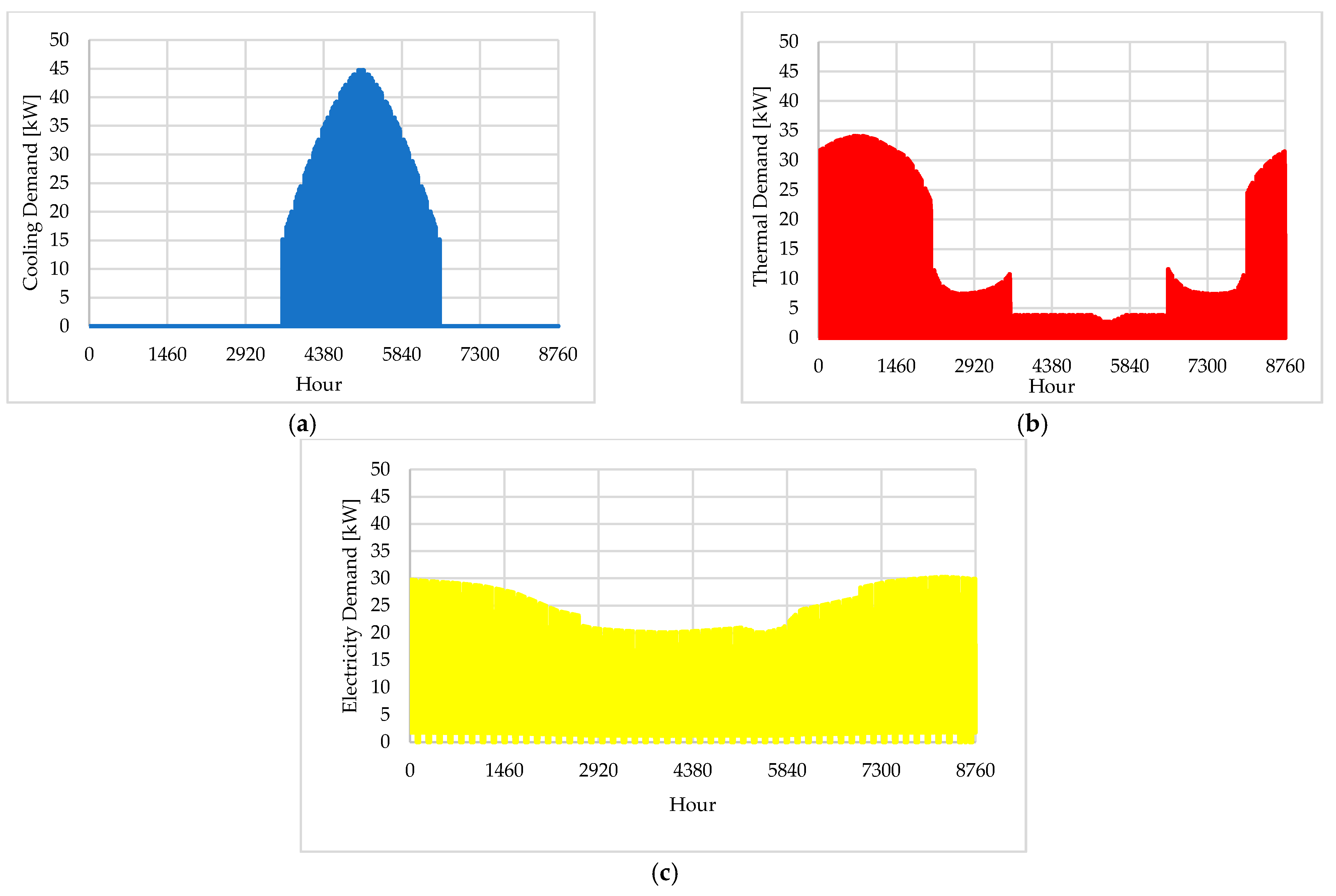


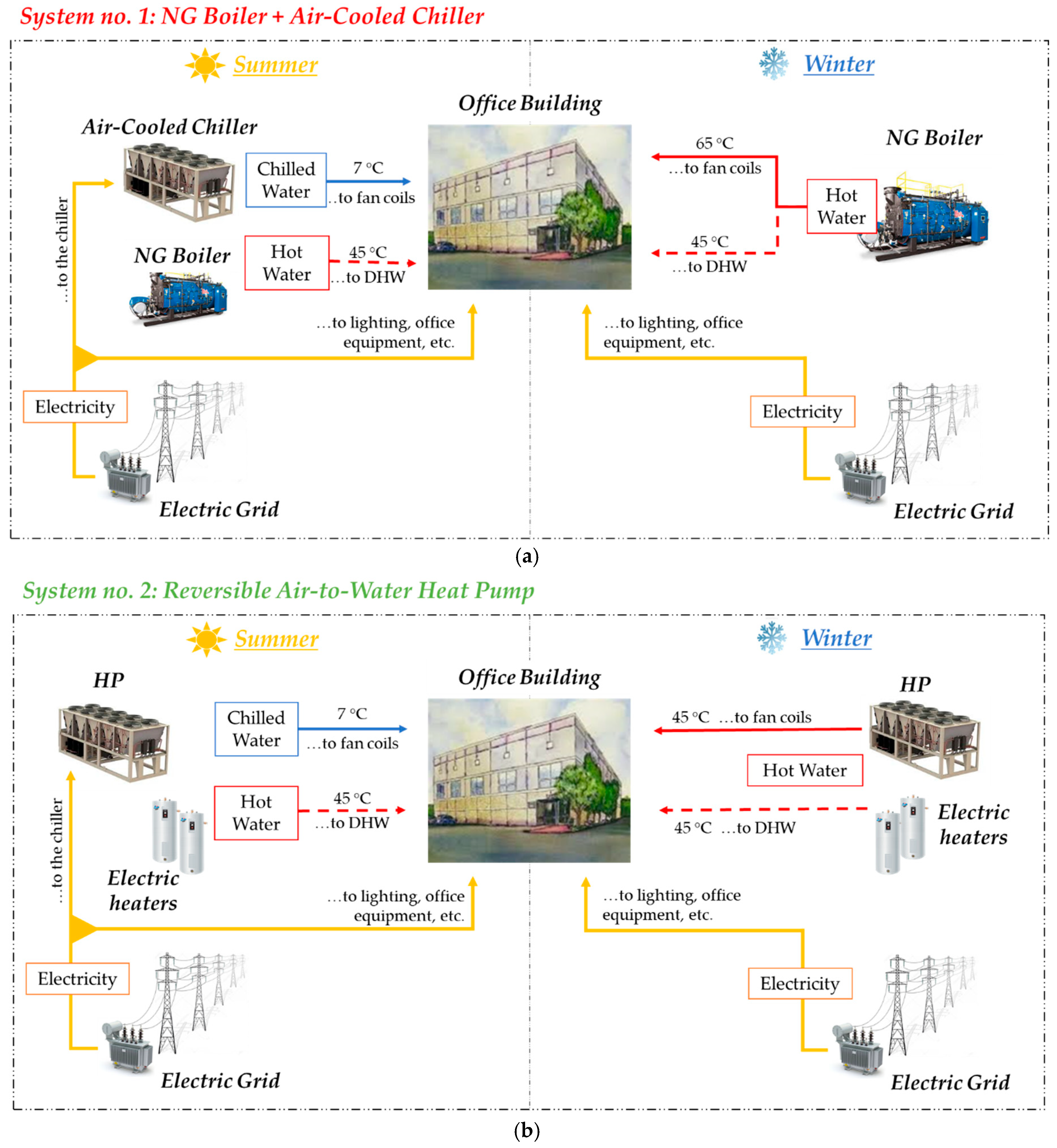
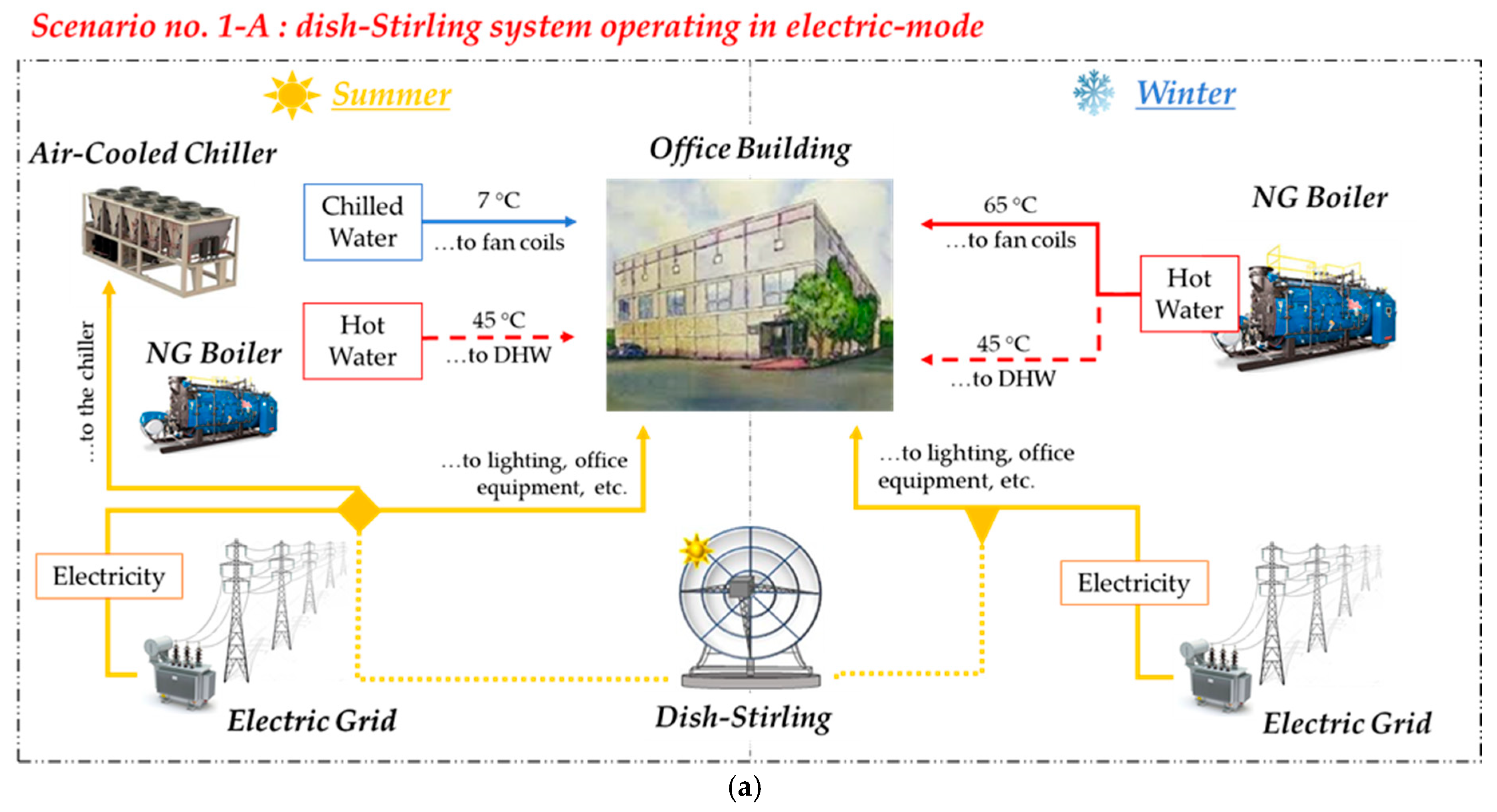



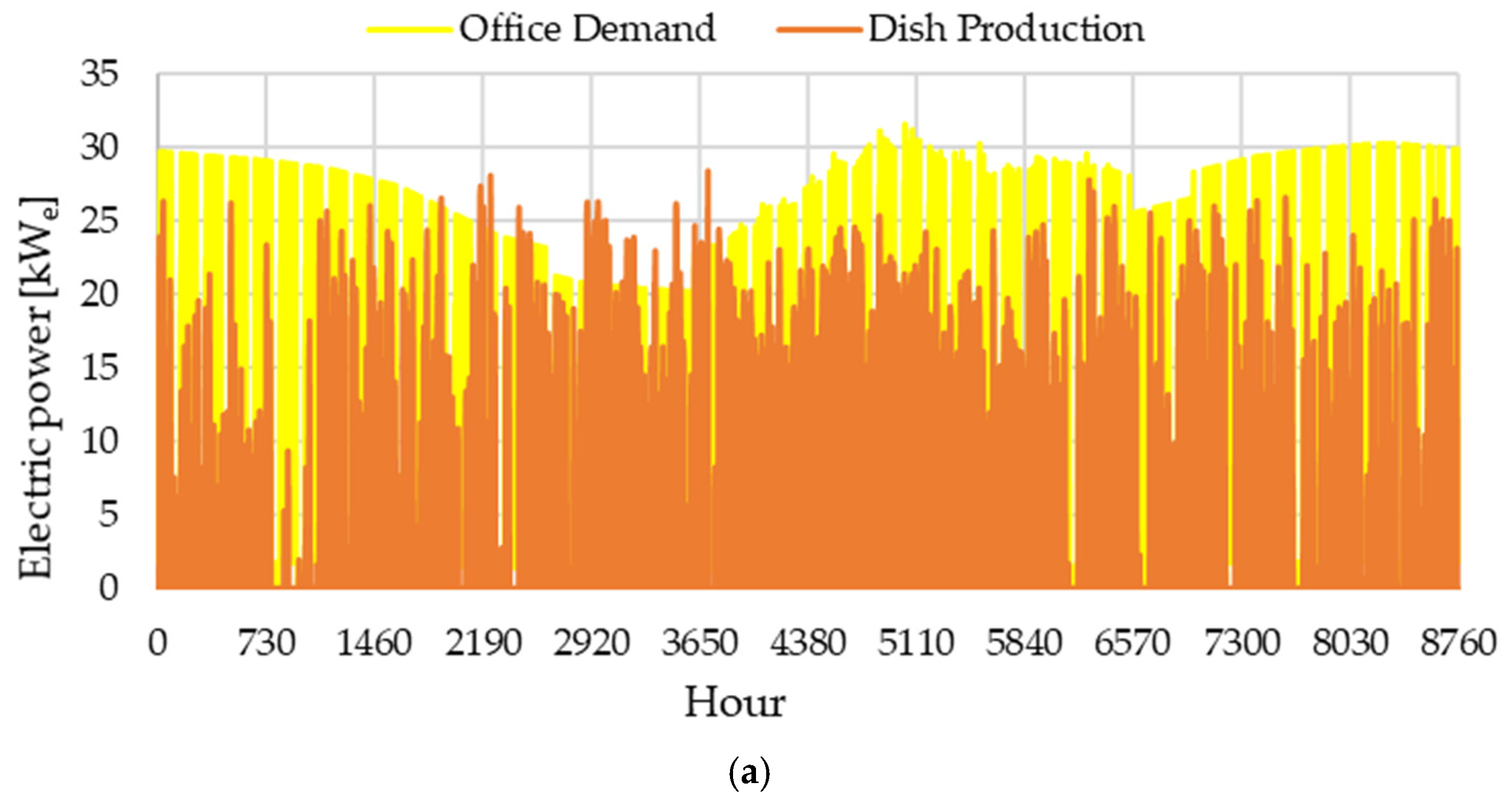
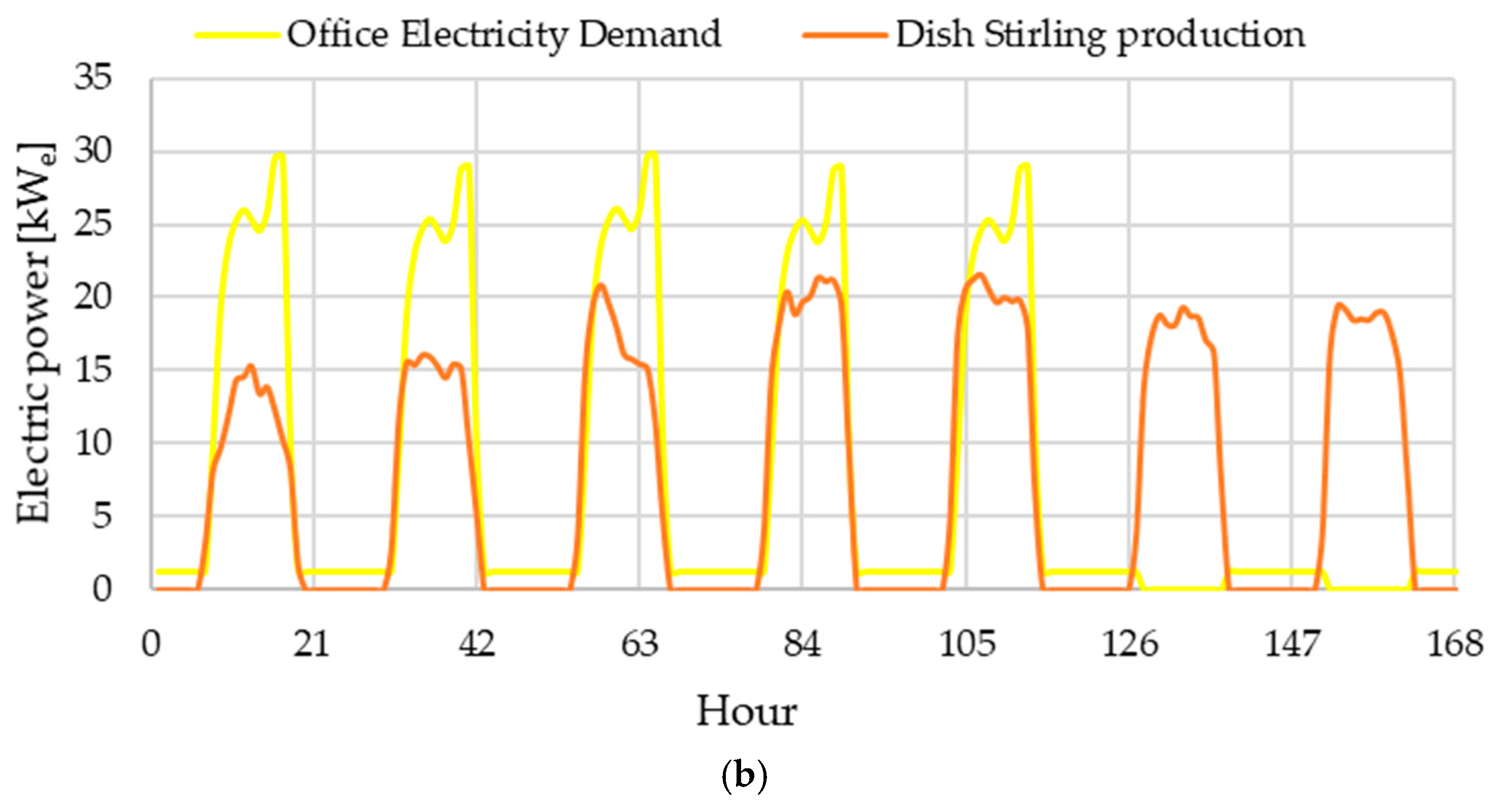

| Reversible Heat Pump Cooling Capacity 1 56 kW Heating Capacity 2 57 kW | Air-Cooled Chiller * Cooling Capacity 1 55 kW | |
|---|---|---|
| Refrigerant | R410A | R410A |
| Condenser | Micro-Channels Heat Exchanger (Number of exchangers: 1; Surface 2.96 m2, Fin pitch 1 mm) | Fin and Tube Heat Exchanger (Tube diameter 9.2 mm, 3 tube rows, fin density 16 fins per inch) |
| 2 Fan, 1.95 kW each | 2 Fan, 1.20 kW | |
| (Air Flowrate per fan 16,388 m3/h) | (Air Flowrate per fan 12,362 m3/h) | |
| Metering Device | Electronic Expansion Valve | Electronic Expansion Valve |
| Evaporator | Brazed Plate Heat Exchanger | Brazed Plate Heat Exchanger |
| Dimension in (mm) Width = 526, Height = 119, Length = 291 Number of plates 92 | Dimension in (mm) Width = 526, Height = 119, Length = 291 Number of plates 92 | |
| 1 Pump, 1.0 kW (Water flow 9.2 m3/h) | 1 Pump, 1.0 kW (Water flow 9.2 m3/h) | |
| Compressor Type | Scroll | Scroll |
| Swept Volume [cm3/rev] | 88.32 | 103.5 |
| Compressors Power [kW] | 9.44 (each) | 12.4 (each) |
| Number of Compressors | 2 | 2 |
| Oil Charge [dm3] | 6.6 | 7.2 |
| Refrigerant Charge [kg] | 15 | 19.9 |
| Parameter | Value | Unit |
|---|---|---|
| Aperture area of the receiver () | 0.0314 | m2 |
| Average parasitic electric consumption () | 1600 | W |
| Clean mirrors optical efficiency () | 0.85 | - |
| Convective heat transfer coefficient of the receiver () | 10 | W/(m2∙K) |
| Emissivity of the receiver () | 0.88 | - |
| Focal length | 7.45 | m |
| Geometric concentration ratio | 3217 | - |
| Max operating pressure of hydrogen | 200 | bar |
| Mirror cleanliness index () | 0.85 | - |
| Net aperture area of the dish collector () | 106 | m2 |
| Parameter in Equation (6) | 0.475 | - |
| Parameter in Equation (6) | 3318.66 | W |
| Reference temperature () | 25 | °C |
| Reflectivity of clean mirror () | 0.95 | - |
| Temperature of the receiver () | 720 | °C |
| System No. 1 | Scenario No. 1-A | Scenario No. 1-B | |
|---|---|---|---|
| NG consumption [Sm3/y] | 3970.4 | 3970.4 | 601.2 |
| Electricity purchased from the grid [MWhe/y] | 63.64 | 18.01 | 20.14 |
| Electricity produced by the dish-Stirling [MWhe/y] | - | 46.29 | 44.16 |
| CO2 Emissions [kgCO2/y] | 38,107 | 15,976 | 10,866 |
| System No. 2 | Scenario No. 2-A | Scenario No. 2-B | |
|---|---|---|---|
| Electricity Purchased from the Grid [MWhe/y] | 71.45 | 25.15 | 22.95 |
| Electricity Produced by the Dish-Stirling [MWhe/y] | - | 46.30 | 44.16 |
| CO2 Emissions [kgCO2/y] | 34,653 | 12,199 | 11,130 |
| Assumptions | Economic Indicators | Scenario No. 1-A | Scenario No. 1-B | Scenario No. 2-A | Scenario No. 2-B |
|---|---|---|---|---|---|
| (I0, FIT) | NPV [€] | 35,054 | 73,611 | 38,323 | 45,797 |
| DPBT [y] | 18.6 | 14.6 | 18.1 | 17.2 | |
| (Ireduced, FIT) | NPV [€] | 111,445 | 150,002 | 114,713 | 122,187 |
| DPBT [y] | 9.1 | 7.5 | 8.9 | 8.6 |
Publisher’s Note: MDPI stays neutral with regard to jurisdictional claims in published maps and institutional affiliations. |
© 2021 by the authors. Licensee MDPI, Basel, Switzerland. This article is an open access article distributed under the terms and conditions of the Creative Commons Attribution (CC BY) license (http://creativecommons.org/licenses/by/4.0/).
Share and Cite
Guarino, S.; Catrini, P.; Buscemi, A.; Lo Brano, V.; Piacentino, A. Assessing the Energy-Saving Potential of a Dish-Stirling Con-Centrator Integrated Into Energy Plants in the Tertiary Sector. Energies 2021, 14, 1163. https://doi.org/10.3390/en14041163
Guarino S, Catrini P, Buscemi A, Lo Brano V, Piacentino A. Assessing the Energy-Saving Potential of a Dish-Stirling Con-Centrator Integrated Into Energy Plants in the Tertiary Sector. Energies. 2021; 14(4):1163. https://doi.org/10.3390/en14041163
Chicago/Turabian StyleGuarino, Stefania, Pietro Catrini, Alessandro Buscemi, Valerio Lo Brano, and Antonio Piacentino. 2021. "Assessing the Energy-Saving Potential of a Dish-Stirling Con-Centrator Integrated Into Energy Plants in the Tertiary Sector" Energies 14, no. 4: 1163. https://doi.org/10.3390/en14041163






